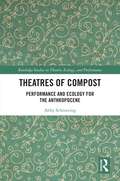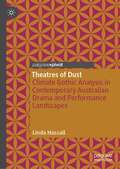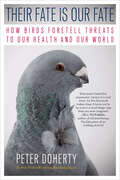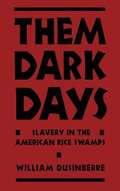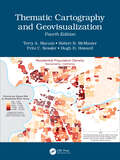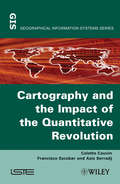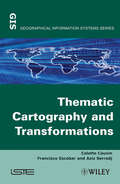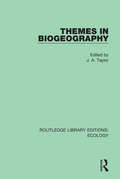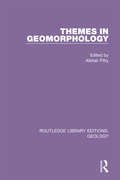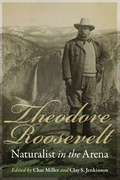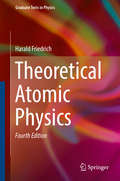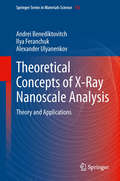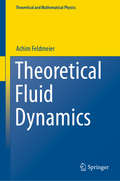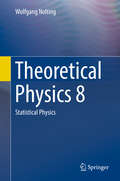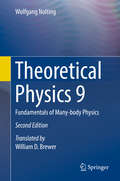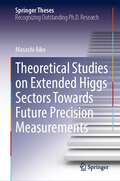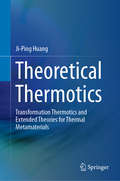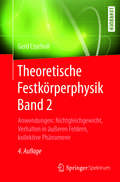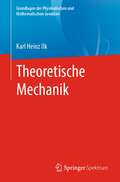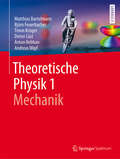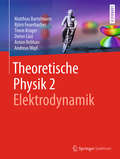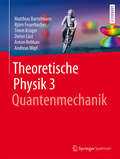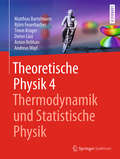- Table View
- List View
Theatres of Compost: Performance and Ecology for the Anthropocene (Routledge Studies in Theatre, Ecology, and Performance)
by Abby SchroeringTheatres of Compost places ecology at the center of performance scholarship and criticism, and it positions performance as a key cultural process for bringing about a more just and sustainable future.Examining a unique archive of agricultural performances—plays, theatre collectives, and activist rituals that engage questions of how humans use the land and produce food—this book lays out a framework for how theatre and performance contribute to a cultural shift toward ecological awareness. Theatre of compost is performance that directly engages ideologies of exploitation, mass production, and accumulation. Instead of discarding the forms, themes, methodologies, and histories that have perpetuated ecological destruction, the case studies in this book show that what has come before can be composted: broken down and reconstituted as the fertile foundation for a more livable life in the Anthropocene. Theatres of Compost will appeal to the new but quickly growing subfield of performance and ecology. As the climate and ecological crises worsen, more scholars and students in theatre and performance will be searching for ways to make their work meaningful and relevant.This book will be a helpful resource for graduate-level courses in performance studies, performance and ecology, and the environmental humanities.
Theatres of Dust: Climate Gothic Analysis in Contemporary Australian Drama and Performance Landscapes
by Linda HassallThrough a contemporary Gothic lens, the book explores theatre theories, processes and practices that explore; the impacts of continuing drought and natural disaster, the conflicts concerning resource extraction and mining and current political debates focussed on climate change denial. While these issues can be argued from various political and economic platforms, theatrical investigations as discussed here suggest that scholars and theatre makers are becoming empowered to dramaturgically explore the ecological challenges we face now and may face in the future. In doing so the book proposes that theatre can engage in not only climate change analysis and discussion but can develop climate literacies in a broader socio-cultural context.
Their Fate Is Our Fate: How Birds Foretell Threats to Our Health and Our World
by Peter DohertyAt the heart of this book by Nobel Prize–winning immunologist and professor Peter Doherty is this striking observation: Birds detect danger to our health and the environment before we do. Following a diverse cast of bird species around the world—from tufted puffins in Puget Sound to griffon vultures in India, pigeons in East Asia, and wedge-tailed shearwaters off the islands of Australia’s Great Barrier Reef—Doherty illuminates birds’ role as an early warning system for threats to the health of our planet and our own well-being.Their Fate Is Our Fate is an impassioned call not only to attention but to action. As “citizen scientists” we can collect data, vital to cutting-edge research, that depends on the birds that are all around us. Armed with our observations, scientists will continue to uncover new ways to glimpse our future in birds—and to affirm how, truly, their fate is our fate.
Them Dark Days: Slavery in the American Rice Swamps
by William DusinberreDusinberre offers both a vivid reconstruction of slavery in action and an analysis of slave culture set within a wider context of health, discipline, privilege, and psychology.
Thematic Cartography and Geovisualization
by Terry A. Slocum Robert B. McMaster Fritz C. Kessler Hugh H. HowardThis comprehensive and well-established cartography textbook covers the theory and the practical applications of map design and the appropriate use of map elements. It explains the basic methods for visualizing and analyzing spatial data and introduces the latest cutting-edge data visualization techniques. The fourth edition responds to the extensive developments in cartography and GIS in the last decade, including the continued evolution of the Internet and Web 2.0; the need to analyze and visualize large data sets (commonly referred to as Big Data); the changes in computer hardware (e.g., the evolution of hardware for virtual environments and augmented reality); and novel applications of technology. Key Features of the Fourth Edition: Includes more than 400 color illustrations and it is available in both print and eBook formats. A new chapter on Geovisual Analytics and individual chapters have now been dedicated to Map Elements, Typography, Proportional Symbol Mapping, Dot Mapping, Cartograms, and Flow Mapping. Extensive revisions have been made to the chapters on Principles of Color, Dasymetric Mapping, Visualizing Terrain, Map Animation, Visualizing Uncertainty, and Virtual Environments/Augmented Reality. All chapters include Learning Objectives and Study Questions. Provides more than 250 web links to online content, over 730 references to scholarly materials, and additional 540 references available for Further Reading. There is ample material for either a one or two-semester course in thematic cartography and geovisualization. This textbook provides undergraduate and graduate students in geoscience, geography, and environmental sciences with the most valuable up-to-date learning resource available in the cartographic field. It is a great resource for professionals and experts using GIS and Cartography and for organizations and policy makers involved in mapping projects.
Thematic Cartography, Cartography and the Impact of the Quantitative Revolution: Cartography And The Impact Of The Quantitative Revolution
by Francisco Escobar Colette Cauvin Aziz SerradjThis series in three volumes considers maps as constructions resulting from a number of successive transformations and stages integrated in a logical reasoning and an order of choices. Volume 2 focuses on the impact of the quantitative revolution, partially related to the advent of the computer age, on thematic cartography.
Thematic Cartography, Thematic Cartography and Transformations (Wiley-iste Ser.)
by Francisco Escobar Colette Cauvin Aziz SerradjA thematic map is a map that illustrates more than simply geographical relationships or locations, but rather also portrays themes, patterns, or data relating to physical, social, medical, economic, political, or any other aspect of a region or location. Examples include maps that show variations of population density, climate data, wealth, voting intentions, or life expectancy with geographical location. These tools have become central to the work of scientists, practitioners, and students in nearly every field, from epidemiology to political science, and are familiar to members of the public as a common means of expressing complicated and multivariate information in easily understood graphical formats. This set of three volumes on Thematic Cartography considers maps as information constructs resulting from a number of successive information transformations and the products of decision stages, integrated into a logical reasoning and the order of those choices. It thereby provides a thorough understanding of the theoretical basis for thematic mapping, as well as the means of applying the various techniques and methodologies in order to create a desired analytical presentation. This first volume introduces the basics of thematic cartography. The authors present the transformations necessary to the production – using a scientific approach – of any thematic map. Four stages are detailed: from geographic entities to cartographic objects; the [XY] transformation; the [XYZ] cartographic transformations; and the semiotic transformation. Technical aspects giving map-reading keys are also included.
Themes in Biogeography (Routledge Library Editions: Ecology #14)
by J. A. TaylorOriginally published in 1984, Themes in Biogeography presents a broad examination of biogeographical themes, extending across the field of plant and animal ecology and geography. The book provides a detailed and unique investigation into life and its environment and delves into not just geography, and ecology, but provides an interdisciplinary look at these areas across both biological and environmental sciences. The book examines biogeographical themes applying them to areas of research in soils and climate change, as well as in depth studies of plant communities and their animal associates. The book also discusses plants and animals through their taxonomic distribution, and deals with factors of plant geography, using both global and regional examples. This book will be of interest to biologists, ecologists and geographers alike.
Themes in Geomorphology (Routledge Library Editions: Geology #29)
by Alistair PittyThis book, first published in 1985, conveys the flavours of geomorphology and the bases of its ideas. It portrays the positive features of pluralism in geomorphology, and focuses on processes operative and their associated landforms; the distinctive geological settings of karst, volcanicity and tectonic activity; and technological advances.
Theodore Roosevelt, Naturalist in the Arena
by Char Miller Clay S. JenkinsonTheodore Roosevelt&’s scientific curiosity and love of the outdoors proved a defining force throughout his hectic life as a rancher and explorer, police commissioner and governor of New York, vice president and president of the United States. Conservation and natural history were parts of a whole for this driven, charismatic public servant, and Roosevelt approached the natural world with joy and a passionate engagement. Drawing on an array of approaches—biographical, ecological and environmental, literary and political, Theodore Roosevelt, Naturalist in the Arena analyzes this energetic man&’s manifold encounters with the great outdoors. George Bird Grinnell, Gifford Pinchot, John Muir, and William Hornaday were among the many conservationists with whom Roosevelt corresponded, collaborated, hiked, and governed—and in turn, inspired. Together, Roosevelt and his contemporaries developed a progressive argument for the conservation of natural resources as a way to construct a more democratic nation-state. This legacy also comes with some troubling domestic and global implications, as Roosevelt fused his call for the conservation of resources—natural and human, domestically and internationally—with a deep-seated conviction that some were more fit than others to control the world and define its future.
Theoretical Atomic Physics
by Harald FriedrichThis expanded and updated well-established textbook contains an advanced presentation of quantum mechanics adapted to the requirements of modern atomic physics. It includes topics of current interest such as semiclassical theory, chaos, atom optics and Bose-Einstein condensation in atomic gases. In order to facilitate the consolidation of the material covered, various problems are included, together with complete solutions. The emphasis on theory enables the reader to appreciate the fundamental assumptions underlying standard theoretical constructs and to embark on independent research projects. The fourth edition of Theoretical Atomic Physics contains an updated treatment of the sections involving scattering theory and near-threshold phenomena manifest in the behaviour of cold atoms (and molecules). Special attention is given to the quantization of weakly bound states just below the continuum threshold and to low-energy scattering and quantum reflection just above. Particular emphasis is laid on the fundamental differences between long-ranged Coulombic potentials and shorter-ranged potentials falling off faster than 1/r2 at large distances r. The new sections on tunable near-threshold Feshbach resonances and on scattering in two spatial dimensions also address problems relevant for current and future research in the field of cold (and ultra-cold) atoms. Graduate students and researchers will find this book a valuable resource and comprehensive reference alike.
Theoretical Concepts in Physics
by Malcolm S. LongairThis second edition of a popular text demonstrates how physics can be appreciated through a series of case studies spanning a complete university physics course. Highlights include three new chapters on Newton's laws (one on ancient astronomy up to the time of Galileo, one on Galileo, and one on Newton); a new chapter on dimensional methods, chaos and self-organized criticality; and a new chapter on the technology of cosmology. Although all the arguments are presented precisely in physical and mathematical terminology, the book is written in a relatively non-technical manner, intended to convey a deep understanding and appreciation of the incredible achievements of theorists in creating the structure of modern physics. First Edition Hb (1984): 0-521-25550-3 First Edition Pb (1984): 0-521-27553-9
Theoretical Concepts of X-Ray Nanoscale Analysis: Theory, Experiments and Applications
by Ilya Feranchuk Alexander Ulyanenkov Andrei BenediktovichThis book provides a concise survey of modern theoretical concepts of X-ray materials analysis. The principle features of the book are: basics of X-ray scattering, interaction between X-rays and matter and new theoretical concepts of X-ray scattering. The various X-ray techniques are considered in detail: high-resolution X-ray diffraction, X-ray reflectivity, grazing-incidence small-angle X-ray scattering and X-ray residual stress analysis. All the theoretical methods presented use the unified physical approach. This makes the book especially useful for readers learning and performing data analysis with different techniques. The theory is applicable to studies of bulk materials of all kinds, including single crystals and polycrystals as well as to surface studies under grazing incidence. The book appeals to researchers and graduate students alike.
Theoretical Fluid Dynamics (Theoretical and Mathematical Physics)
by Achim FeldmeierThis textbook gives an introduction to fluid dynamics based on flows for which analytical solutions exist, like individual vortices, vortex streets, vortex sheets, accretions disks, wakes, jets, cavities, shallow water waves, bores, tides, linear and non-linear free-surface waves, capillary waves, internal gravity waves and shocks. Advanced mathematical techniques ("calculus") are introduced and applied to obtain these solutions, mostly from complex function theory (Schwarz-Christoffel theorem and Wiener-Hopf technique), exterior calculus, singularity theory, asymptotic analysis, the theory of linear and nonlinear integral equations and the theory of characteristics.Many of the derivations, so far contained only in research journals, are made available here to a wider public.
Theoretical Mantle Dynamics
by Neil M. RibeGeodynamics is the study of the deformation and flow of the solid Earth and other planetary interiors. Focusing on the Earth's mantle, this book provides a comprehensive, mathematically advanced treatment of the continuum mechanics of mantle processes and the craft of formulating geodynamical models to approximate them. Topics covered include slow viscous flow, elasticity and viscoelasticity, boundary-layer theory, long-wave theories including lubrication theory and shell theory, two-phase flow, and hydrodynamic stability and thermal convection. A unifying theme is the utility of powerful general methods (dimensional analysis, scaling analysis, and asymptotic analysis) that can be applied in many specific contexts. Featuring abundant exercises with worked solutions for graduate students and researchers, this book will make a useful resource for Earth scientists and applied mathematicians with an interest in mantle dynamics and geodynamics more broadly.
Theoretical Physics 8: Statistical Physics
by Wolfgang NoltingDer Grundkurs Theoretische Physik deckt in 7 Bänden alle für das Diplom und für Bachelor/Master-Studiengänge maßgeblichen Gebiete ab. Jeder Band vermittelt das im jeweiligen Semester notwendige theoretisch-physikalische Rüstzeug. Übungsaufgaben mit ausführlichen Lösungen dienen der Vertiefung des Stoffs. Der 6. Band zur Statistischen Physik wurde für die Neuauflage grundlegend überarbeitet und um aktuelle Entwicklungen ergänzt. Durch die zweifarbige Gestaltung ist der Stoff jetzt noch übersichtlicher gegliedert.
Theoretical Physics 9: Fundamentals of Many-body Physics
by Wolfgang NoltingThis textbook addresses the special physics of many-particle systems, especially those dominated by correlation effects. It develops modern methods to treat such systems and demonstrates their application through numerous appropriate exercises, mainly from the field of solid state physics. The book is written in a tutorial style appropriate for those who want to learn many-body theory and eventually to use this to do research work in this field. The exercises, together with full solutions for evaluating one's performance, help to deepen understanding of the main aspects of many-particle systems.This revised second edition presents new sections on the finite-temperature Matsubara formalism, in particular with respect to Dyson equation, the Hartree-Fock approximation, second order perturbation theory, spin density waves, Hubbard model, Jellium model, quasi particles, Fermi liquids and multi particle Matsubara functions.Completing the outstanding Theoretical Physics series, this book will be a valuable resource for advanced students and researchers alike.
Theoretical Studies on Extended Higgs Sectors Towards Future Precision Measurements (Springer Theses)
by Masashi AikoThis book investigates the physics of the discovered Higgs boson and additional Higgs bosons in the extended Higgs models which includes higher-order quantum corrections. While the 125 GeV Higgs boson was discovered, the structure of the Higgs sector is still a mystery. Since the Higgs sector determines the concrete realization of the Higgs mechanism, the study of its nature is one of the central interests in current and future high-energy physics. The book begins with a review of the standard model and the two-Higgs doublet model, which is one of the representatives of the extended Higgs models. Subsequently, we discuss the studies of the two-Higgs doublet model at the lowest order of perturbation. Following the lowest-order analysis, we study the higher-order electroweak corrections in Higgs physics. After reviewing the renormalization procedure and the higher-order corrections in the decays of the discovered Higgs boson, we discuss the higher-order corrections in the Higgs strahlung process from an electron-positron collision, the decays of the additional charged and CP-odd Higgs bosons in the two-Higgs doublet model. From the series of these studies, it is found that the nature of the Higgs sector can be widely investigated by future collider experiments.
Theoretical Thermotics: Transformation Thermotics and Extended Theories for Thermal Metamaterials
by Ji-Ping HuangThis book focuses on theoretical thermotics, the theory of transformation thermotics and its extended theories for the active control of macroscopic thermal phenomena of artificial systems, which is in sharp contrast to classical thermodynamics comprising the four thermodynamic laws for the passive description of macroscopic thermal phenomena of natural systems. The book covers the basic concepts and mathematical methods, which are necessary to understand thermal problems extensively investigated in physics, but also in other disciplines of engineering and materials. The analyses rely on models solved by analytical techniques accompanied with computer simulations and laboratory experiments. This book serves both as a reference work for senior researchers and a study text for zero beginners.
Theoretische Festkörperphysik Band 2: Anwendungen: Nichtgleichgewicht, Verhalten in äußeren Feldern, kollektive Phänomene
by Gerd CzychollDer vorliegende Band 2 deckt fortgeschrittene Themen der theoretischen Festkörperphysik ab und knüpft damit direkt an die Grundlagen an. Dabei werden Festkörper in äußeren Feldern bzw. allgemeiner im Nichtgleichgewicht und Abweichungen von der idealen 3-dimensionalen Kristallstruktur (Oberflächen, Störstellen, niederdimensionale Strukturen, Quantenpunkte, etc.) behandelt. Die Betrachtung von kollektiven Phänomene wie Supraleitung und Magnetismus runden die Darstellung ab. Beim Leser werden die Inhalte von Band 1 (Elektronen und Phononen in idealen Kristallen, Bloch-Theorem, Besetzungszahldarstellung bzw. 2. Quantisierung, Elektron-Elektron- und Elektron-Phonon-Wechselwirkung) vorausgesetzt sowie die Grundkenntnisse in allgemeiner Theoretischer Physik (Mechanik, Elektrodynamik, Quantenmechanik und Statistische Physik), wie sie in der Regel nach einem Bachelor-Studium der Physik vorhanden sind. Band 2 eignet sich also hervorragend für Studierende im Master-Studiengang Physik, die sich auf (experimentelle oder theoretische) Festkörperphysik spezialisieren wollen. Das Ansprechen von aktuellen Themen (z.B. Kondo-Effekt, fraktioneller Quanten-Hall-Effekt, 2-dimensionale Kristalle wie Graphen, Riesen-Magnetowiderstands-Effekt u.a.) bietet einen optimalen Übergang zur modernen Forschung.Die Neuauflage wurde komplett überarbeitet, um zahlreiche Übungsaufgaben erweitert und vorhandene neu konzipiert, wobei die zugehörigen Lösungen nun mit ins Buch aufgenommen sind.
Theoretische Mechanik (Grundlagen der Physikalischen und Mathematischen Geodäsie)
by Karl Heinz IlkDieses Lehrbuch aus der Reihe „Grundlagen der Physikalischen und Mathematischen Geodäsie“ behandelt die Elemente der klassischen Mechanik, die für die Modellbildung der Physikalischen Geodäsie, insbesondere im Rahmen der Nutzung künstlicher Erdsatelliten, wichtig sind. Detailliert geht der Autor auf die Mechanik von Mehrkörpersystemen gravitierender Teilchen, die Mechanik starrer Körper sowie die Eulerschen Kreiselgleichungen und die Rotationsbewegung von starren Körpern mit verschiedenen Trägheitsmomenten ein. Anwendungsbeispiele der wichtigen geodätischen Bewegungsprobleme verdeutlichen die Zusammenhänge. Weiterhin gibt der Autor eine Einführung in die Mechanik deformierbarer Körper, in die Lagrangesche Formulierung der klassischen Mechanik sowie in den Hamilton-Formalismus. Ausgewählte einfache Beispiele erleichtern das Verständnis und veranschaulichen jeweils die Anwendungen in der Geodäsie.
Theoretische Physik 1 | Mechanik: Mechanik
by Matthias Bartelmann Timm Krüger Björn Feuerbacher Andreas Wipf Dieter Lüst Anton RebhanDas beliebte Buch Theoretische Physik wird jetzt erstmalig in korrigierter und ergänzter Form in Einzelbänden angeboten. Das ermöglicht den Studierenden, die handlichen Bände zum Lernen, Aufgabenlösen und zum schnellen Nachschlagen leichter mitnehmen und nutzen zu können. Gleichzeitig wird die gesamte theoretische Physik des Bachelorstudiums (und darüber hinaus) in den vier Bänden aufeinander abgestimmt präsentiert. Das vorliegende Buch ist der erste Teil der vierbändigen Reihe und deckt den Lehrstoff der Bachelorvorlesung zur Theoretischen Mechanik großer Universitäten in Deutschland, Österreich und der Schweiz möglichst umfassend ab.Die besondere Stärke dieser Reihe liegt darin, den Leser mit einer Vielzahl von didaktischen Elementen beim Lernen zu unterstützen:-Alle Kapitel werden mit grundsätzlichen Fragen eingeleitet-Wichtige Aussagen, Formeln und Definitionen sind übersichtlich hervorgehoben-Beispiele regen zum Aktivwerden an-Selbstfragen helfen dem Leser, den behandelten Stoff zu reflektieren-„So geht’s weiter“-Abschnitte, beispielsweise über den Lense-Thirring-Effekt oder Determinismus und Chaos ermöglichen einen Blick über den Tellerrand und geben Einblicke in aktuelle Forschung-Anhand ausführlich gelöster Aufgaben kann das Gelernte überprüft und gefestigt werden-Mathematische Boxen sind zum schnellen Nachschlagen herausgehoben -Alle Bände sind durchgehend vierfarbig und mit übersichtlichen Grafiken gestaltet.Die Autoren haben ihre langjährige und vielfach hervorragend bewertete Lehrerfahrung in das Werk einfließen lassen. Darüber hinaus gelingt es ihnen, die Zusammenhänge in der Theoretischen Physik auch bandübergreifend klar werden zu lassen.Der InhaltDie Newton’schen Axiome – Koordinationstransformationen und beschleunigte Bezugssysteme – Systeme von Punktmassen – Starre Körper – Lagrange-Formalismus und Variationsrechnung – Schwingungen – Hamilton-Formalismus – Kontinuumsmechanik – Spezielle Relativitätstheorie – Relativistische Mechanik
Theoretische Physik 2 | Elektrodynamik
by Matthias Bartelmann Timm Krüger Björn Feuerbacher Andreas Wipf Dieter Lüst Anton RebhanDas beliebte Buch Theoretische Physik wird jetzt erstmalig in korrigierter und ergänzter Form in Einzelbänden angeboten. Das ermöglicht den Studierenden, die handlichen Bände zum Lernen, Aufgabenlösen und zum schnellen Nachschlagen leichter mitnehmen und nutzen zu können. Gleichzeitig wird die gesamte theoretische Physik des Bachelorstudiums (und darüber hinaus) in den vier Bänden aufeinander abgestimmt präsentiert. Das vorliegende Buch ist der zweite Teil der vierbändigen Reihe und deckt den Lehrstoff der Bachelorvorlesung zur Elektrodynamik großer Universitäten in Deutschland, Österreich und der Schweiz möglichst umfassend ab. Die besondere Stärke dieser Reihe liegt darin, den Leser mit einer Vielzahl von didaktischen Elementen beim Lernen zu unterstützen: -Alle Kapitel werden mit grundsätzlichen Fragen eingeleitet -Wichtige Aussagen, Formeln und Definitionen sind übersichtlich hervorgehoben -Beispiele regen zum Aktivwerden an -Selbstfragen helfen dem Leser, den behandelten Stoff zu reflektieren -„So geht’s weiter“-Abschnitte, beispielsweise über nichtlineare Elektrodynamik und effektive Feldtheorien ermöglichen einen Blick über den Tellerrand und geben Einblicke in aktuelle Forschung -Anhand ausführlich gelöster Aufgaben kann das Gelernte überprüft und gefestigt werden -Mathematische Boxen sind zum schnellen Nachschlagen herausgehoben -Alle Bände sind durchgehend vierfarbig und mit übersichtlichen Grafiken gestaltet. Die Autoren haben ihre langjährige und vielfach hervorragend bewertete Lehrerfahrung in das Werk einfließen lassen. Darüber hinaus gelingt es ihnen, die Zusammenhänge in der Theoretischen Physik auch bandübergreifend klar werden zu lassen. Der Inhalt Die Maxwell-Gleichungen – Elektrostatik – Vollständige Funktionssysteme: Fourier-Transformation und Multipolentwicklung – Elektrische Felder in Materie – Magnetismus und elektrische Ströme – Ausbreitung elektromagnetischer Wellen – Optik – Relativistische Formulierung der Elektrodynamik – Abstrahlung elektromagnetischer Wellen – Lagrange- und Hamilton-Formalismus in der Elektrodynamik
Theoretische Physik 3 | Quantenmechanik: Quantenmechanik 1
by Matthias Bartelmann Timm Krüger Björn Feuerbacher Andreas Wipf Dieter Lüst Anton RebhanDas beliebte Buch Theoretische Physik wird jetzt erstmalig in korrigierter und ergänzter Form in Einzelbänden angeboten. Das ermöglicht den Studierenden, die handlichen Bände zum Lernen, Aufgabenlösen und zum schnellen Nachschlagen leichter mitnehmen und nutzen zu können. Gleichzeitig wird die gesamte theoretische Physik des Bachelorstudiums (und darüber hinaus) in den vier Bänden aufeinander abgestimmt präsentiert. Das vorliegende Buch ist der dritte Teil der vierbändigen Reihe und deckt den Lehrstoff der Bachelorvorlesung zur Quantenmechanik großer Universitäten in Deutschland, Österreich und der Schweiz möglichst umfassend ab. Die besondere Stärke dieser Reihe liegt darin, den Leser mit einer Vielzahl von didaktischen Elementen beim Lernen zu unterstützen: -Alle Kapitel werden mit grundsätzlichen Fragen eingeleitet -Wichtige Aussagen, Formeln und Definitionen sind übersichtlich hervorgehoben -Beispiele regen zum Aktivwerden an -Selbstfragen helfen dem Leser, den behandelten Stoff zu reflektieren -„So geht’s weiter“-Abschnitte, beispielsweise über Supersymmetrie in der Quantenmechanik ermöglichen einen Blick über den Tellerrand und geben Einblicke in aktuelle Forschung -Anhand ausführlich gelöster Aufgaben kann das Gelernte überprüft und gefestigt werden -Mathematische Boxen sind zum schnellen Nachschlagen herausgehoben -Alle Bände sind durchgehend vierfarbig und mit übersichtlichen Grafiken gestaltet. Die Autoren haben ihre langjährige und vielfach hervorragend bewertete Lehrerfahrung in das Werk einfließen lassen. Darüber hinaus gelingt es ihnen, die Zusammenhänge in der Theoretischen Physik auch bandübergreifend klar werden zu lassen. Der Inhalt Die Entstehung der Quantenphysik – Wellenmechanik – Formalismus der Quantenmechanik – Observablen, Zustände und Unbestimmtheit – Zeitentwicklung und Bilder – Eindimensionale Quantensysteme – Symmetrien und Erhaltungssätze – Zentralkräfte, das Wasserstoffatom – Elektromagnetische Felder und der Spin – Störungstheorie und Virialsatz – Mehrteilchensysteme und weitere Näherungsmethoden – Streutheorie
Theoretische Physik 4 | Thermodynamik und Statistische Physik
by Matthias Bartelmann Timm Krüger Björn Feuerbacher Andreas Wipf Dieter Lüst Anton RebhanDas beliebte Buch Theoretische Physik wird jetzt erstmalig in korrigierter und ergänzter Form in Einzelbänden angeboten. Das ermöglicht den Studierenden, die handlichen Bände zum Lernen, Aufgabenlösen und zum schnellen Nachschlagen leichter mitnehmen und nutzen zu können. Gleichzeitig wird die gesamte theoretische Physik des Bachelorstudiums (und darüber hinaus) in den vier Bänden aufeinander abgestimmt präsentiert. Das vorliegende Buch ist der vierte Teil der vierbändigen Reihe und deckt den Lehrstoff der Bachelorvorlesung zur Thermodynamik und Statistischen Physik großer Universitäten in Deutschland, Österreich und der Schweiz möglichst umfassend ab. Die besondere Stärke dieser Reihe liegt darin, den Leser mit einer Vielzahl von didaktischen Elementen beim Lernen zu unterstützen: -Alle Kapitel werden mit grundsätzlichen Fragen eingeleitet -Wichtige Aussagen, Formeln und Definitionen sind übersichtlich hervorgehoben -Beispiele regen zum Aktivwerden an -Selbstfragen helfen dem Leser, den behandelten Stoff zu reflektieren -„So geht’s weiter“-Abschnitte, beispielsweise über das Curie-Weiss-Modell, Weiße Zwerge und Systeme außerhalb des Gleichgewichts ermöglichen einen Blick über den Tellerrand und geben Einblicke in aktuelle Forschung -Anhand ausführlich gelöster Aufgaben kann das Gelernte überprüft und gefestigt werden -Mathematische Boxen sind zum schnellen Nachschlagen herausgehoben -Alle Bände sind durchgehend vierfarbig und mit übersichtlichen Grafiken gestaltet. Die Autoren haben ihre langjährige und vielfach hervorragend bewertete Lehrerfahrung in das Werk einfließen lassen. Darüber hinaus gelingt es ihnen, die Zusammenhänge in der Theoretischen Physik auch bandübergreifend klar werden zu lassen. Der Inhalt Phänomenologische Begründung der Thermodynamik – Statistische Begründung der Thermodynamik – Einfache thermodynamische Anwendungen – Ensembles und Zustandssummen – Quantenstatistik
